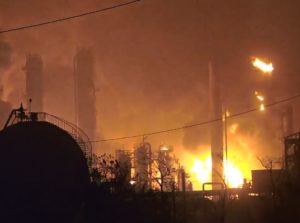What caused the 2019 TPC explosion? New report from Chemical Safety Board details 6,000 gallon butadiene leak
What caused the 2019 TPC explosion? New report from Chemical Safety Board details 6,000 gallon butadiene leak
In 50 seconds, about 6,000 gallons of liquid vapor, mostly butadiene, escaped a processing tower at the TPC plant in Port Neches. The explosion was 2 minutes later.
New information is being released about the explosion at the TPC plant in 2019.
The Chemical Safety Board released a new 13-page report detailing the timeline and what led up to the TPC explosion.
Nearly a year later, an attorney is calling this report a step forward.
Federal officials said about 6,000 gallons of liquid vapor, mostly butadiene escape one of the processing towers at the TPC plant in Port Neches. Two minutes later, the plant was on fire.
While the investigation into the explosion is not over, the report summarizes what happened before and after the explosion.
Once the investigation comes to an end, TPC will take actions to address any of the Chemical Safety Board’s concerns, a TPC spokesperson said in a statement.
“By and large, I think it’s what we expected,” Attorney Eric Newell said. Newell is an attorney with Brent Coon and Associates in Beaumont.
He said this CSB report confirmed what he and others have already been suspecting.
“One of the main things that we were gonna be looking at early one was the popcorning in the pipes,” Newell said.
The report discusses something called popcorn polymer, which can form in equipment when oxygen and butadiene react.
Eight days before the explosion, TPC installed temporary filters to catch any popcorn polymer chunks, according to the report.
“So the question that we’re going to be asking is, did they take steps to prevent it?” Newell said. “There are some additives that they can put in there that could have limited the popcorning.”
“While the CSB has been conducting its investigation, TPC already has begun implementing a comprehensive program to review its systems for identifying and mitigating butadiene hazards,” TPC spokesperson Sara Cronin said in an emailed statement Friday afternoon.
There are still many questions, but this report is a step forward, Newell said.
“It’s just a good starting point that confirms some of the suspicions that we had initially,” he said.
search
our offices
FROM THE BLOG
Uninsured Motorist Accidents: What to Do
If you get in an uninsured motorist accident, you will have to pay extra attention to the next steps to make sure you get compensated for property damage and injuries. We recommend going through the steps below and also contacting a Beaumont car accident lawyer who can give you the most accurate and actionable suggestions…
Boeing Finally Settles Lawsuit of Deadly Spanair Crash After 15 Years of Legal Battles
PRESS ANNOUNCEMENT Boeing Finally Settles Lawsuit of Deadly Spanair Crash After 15 Years of Legal Battles Boeing has finally settled for an undisclosed amount in the lawsuit that resulted from the deaths of 154 passengers and crewmembers in Spain over 15 years ago. The case was brought against Boeing as the manufacturer of the ill-…
Is A City Housing Authority Entitled to Sovereign Immunity in an Auto Accident?
If you’ve been in an auto accident caused by a Housing Authority driver, and have suffered injuries and economic losses, you have the right to sue the Housing Authority for damages. Will the lawsuit go through or be thrown out of court? Even if they caused the accident, is the City Housing Authority driver protected…



